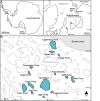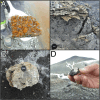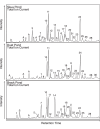Biosignatures of diverse eukaryotic life from a Snowball Earth analogue environment in Antarctica
- PMID: 40537504
- PMCID: PMC12179283
- DOI: 10.1038/s41467-025-60713-5
Biosignatures of diverse eukaryotic life from a Snowball Earth analogue environment in Antarctica
Abstract
The ephemeral, supraglacial meltwater ponds of the McMurdo Ice Shelf's undulating ice serve as analogues for refugia where eukaryotic organisms could have thrived during the Cryogenian period. The seafloor sediment and debris lined ponds support the growth of a diverse array of cyanobacterial mat communities and provide habitats for a variety of protists and meiofauna. Here, we show that these eukaryotic assemblages, assessed by steroid biomarker and 18S rRNA gene analyses, inform long-standing questions regarding the diversity of, and controls on, community composition in these environments. Sixteen photosynthetically active microbial mats from meltwater ponds, a 700-year-old relict microbial mat, and a microbial mat from the Bratina Lagoon were analysed for their sterol compositions. These sterols were subjected to simulated diagenesis via catalytic hydrogenation/hydrogenolysis affording their sterane hydrocarbon counterparts, facilitating comparisons with ancient settings. Pond salinity appeared to be a factor influencing the sterol distributions observed. Analyses of 18S rRNA gene sequences conducted on the modern mats independently confirm that the ponds host diverse eukaryotes, including many types of microalgae, protists, and an array of unclassifiable organisms. Our findings support the hypothesis that supraglacial meltwater ponds like those of the McMurdo ice are strong candidates for refugia that sheltered complex life during Snowball Earth episodes.
© 2025. The Author(s).
Conflict of interest statement
Competing interests: The authors declare no competing interests.
Figures







Similar articles
-
DNA Metabarcoding Focusing on Eukaryote Communities on Langhovde Glacier, East Antarctica.Environ Microbiol Rep. 2025 Aug;17(4):e70117. doi: 10.1111/1758-2229.70117. Environ Microbiol Rep. 2025. PMID: 40602625 Free PMC article.
-
Tracing non-fungal eukaryotic diversity via shotgun metagenomes in the complex mudflat intertidal zones.mSystems. 2025 Jul 22;10(7):e0041325. doi: 10.1128/msystems.00413-25. Epub 2025 Jun 12. mSystems. 2025. PMID: 40503898 Free PMC article.
-
Environmental diversity of Candidatus Babelota and their relationships with protists.mSystems. 2025 Jun 17;10(6):e0026125. doi: 10.1128/msystems.00261-25. Epub 2025 May 28. mSystems. 2025. PMID: 40434078 Free PMC article.
-
Factors that influence parents' and informal caregivers' views and practices regarding routine childhood vaccination: a qualitative evidence synthesis.Cochrane Database Syst Rev. 2021 Oct 27;10(10):CD013265. doi: 10.1002/14651858.CD013265.pub2. Cochrane Database Syst Rev. 2021. PMID: 34706066 Free PMC article.
-
Factors that influence the provision of intrapartum and postnatal care by skilled birth attendants in low- and middle-income countries: a qualitative evidence synthesis.Cochrane Database Syst Rev. 2017 Nov 17;11(11):CD011558. doi: 10.1002/14651858.CD011558.pub2. Cochrane Database Syst Rev. 2017. PMID: 29148566 Free PMC article.
References
-
- Harland, W. B. Critical evidence for a great infra-Cambrian glaciation. Geol. Rundsch.54, 45–61 (1964).
-
- Hoffman, P. F. & Schrag, D. P. The snowball Earth hypothesis: testing the limits of global change. Terra Nova14, 129–155 (2002).
-
- Kirschvink, J. L. Late Proterozoic low-latitude global glaciation: the snowball Earth. In The Proterozoic Biosphere (eds Schopf, J.W. & Klein, C.) 51–52 (Cambridge University Press, 1992).
-
- Macdonald, F. A. et al. Calibrating the Cryogenian. Science327, 1241–1243 (2010). - PubMed
MeSH terms
Substances
Grants and funding
- 80NSSC19K0465/NASA | NASA Astrobiology Institute (NAI)
- 80NSSC23K1361/NASA | NASA Astrobiology Institute (NAI)
- 80NSSC19K0465/NASA | NASA Astrobiology Institute (NAI)
- 80NSSC23K1361/NASA | NASA Astrobiology Institute (NAI)
- Feodor Lynen Research Fellowship/Alexander von Humboldt-Stiftung (Alexander von Humboldt Foundation)
LinkOut - more resources
Full Text Sources

